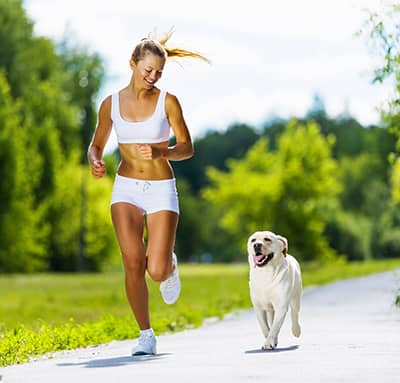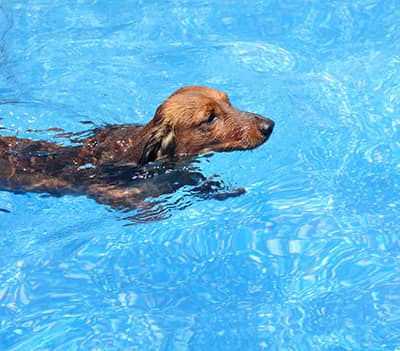
How Much Exercise Does Your Dog Need?
November 10th, 2021
As the saying goes “A tired dog is a good dog!” No matter what breed a dog is, how big they are, how old they are, all dogs need regular exercise to help keep them physically and emotionally healthy. How much is dependent on factors such as size, breed, activity level, health, and age.
Below are general guidelines to follow based age, breed, and health.
Exercise for Puppies
Puppies need bursts of exercise because they have a lot of energy for short periods of time. Plan sessions that last 5 to 10 minutes each, and include activities such as walks, playing games, training, or socializing with another young dog. Take care not to walk your puppy for too long because it’s hard on their developing joints and bones.
Exercise for Adult Dogs
With adult dogs, age and health play a larger role in how much exercise they need. Breed is not as important, but it can give you an indication of what their activity level should be.
Breeds that Have High Exercise Needs
 Some of the more active breeds include:
Some of the more active breeds include:
- Terriers
- Shepherds / Belgian Malinois
- Retrievers
- Border collies / Australian Shepherds
- Hounds
- Working breeds
Healthy, adult active breed dogs require a lot more daily exercise than low energy breeds. Below are some specifics for several different breed classes.
Herding and sporting dogs were bred for jobs that require endurance. They have the greatest need for a hard workout, such as running, playing with other dogs, swimming, hiking or competitive sports. You can also add training sessions in-between workouts to keep things fresh and exciting, and to keep their minds sharp.
Working dogs such as Malamutes, Bernese and Greater Swiss Mountain dogs, Boxers, Doberman Pinschers, and Rottweilers aren’t high activity dogs; instead they are often described as slow and steady. These dogs are happiest with a job, since that’s what they were bred to do. Exercise that suits these breeds include activities such as long walks, hiking, cart or sled pulling, tracking, or swimming.
Terriers are small and feisty but need almost as much exercise as sporting or herding breeds. An hour or two of fun, along with toys and a good amount of mental stimulation will keep them in good condition.
Hounds include breeds such as Beagles, Greyhounds, English Pointers, English springer spaniels and of course a variety of hound breeds. Because this is such a varied class of dogs, their exercise requirements depend on the breed, age and fitness level. Daily walks are always good, but some hounds need the same type and intensity of exercise as the sporting breeds.
Breeds that Have Medium to Low Exercise Needs

While all dogs need some daily exercise, there are breeds that just don’t need that much. These breeds can get by with a short or slow walk, by chasing a ball around the house, or by playing with another dog. If you have mobility issues, time constraints, or simply don’t want the responsibility of a high energy dog, one of these breeds may be for you!
- Basset hounds
- Bulldogs
- Cavalier King Charles Spaniels
- Chihuahuas
- Maltese
- Pugs
- Shih Tzus
- Yorkshire terriers
Toy and small breeds need a good amount of daily exercise, but it can be done in a smaller area. Walking a toy breed at a normal human gait will give them a great workout because their little legs are working hard to keep up! If you’re an apartment dweller, these dogs can also easily be exercised in your home.
Brachycephalic Breeds are short-nosed or flat-faced dogs such as bulldogs and pugs. Because they have shorter snouts than other dogs, they can easily overheat or have breathing problems. As a result, their exercise should include daily, moderate walks of short duration. You also have to watch their exercise in hot weather. Even with these issues, they still need adequate exercise because they are prone to becoming overweight.
Exercise for Senior Dogs

Exercise is a must for senior dogs. As dogs age, they begin to have joint conditions, arthritis, and muscle loss, resulting in mobility issues. The worst thing we can do for our beloved senior dogs is to not exercise them for fear that it may hurt them.
Exercising your senior dog helps keep their minds sharp, their weight under control, and their bodies strong. Despite what your senior dog may be experiencing as they age, there’s always a way to give them exercise. Just be careful not to overdo it. Some ideas include:
- Walking – although most likely at a slower pace
- Short sessions playing games such as fetch
- Swimming – an excellent non-weight bearing exercise to keep seniors strong
- Fitness training – using unstable surfaces such as foam pads to cause muscles to fire
- Strength training – focusing on weak areas
In addition, massage and passive range of motion exercises are an excellent way to keep your senior mobile and healthy.
No matter the breed, age or health condition of your dog, they all require some type of daily exercise to stay healthy and happy. It’s up to you to learn what your dog’s exercise requirements are, and come up with a variety of workouts that best suit both you and your dog.
